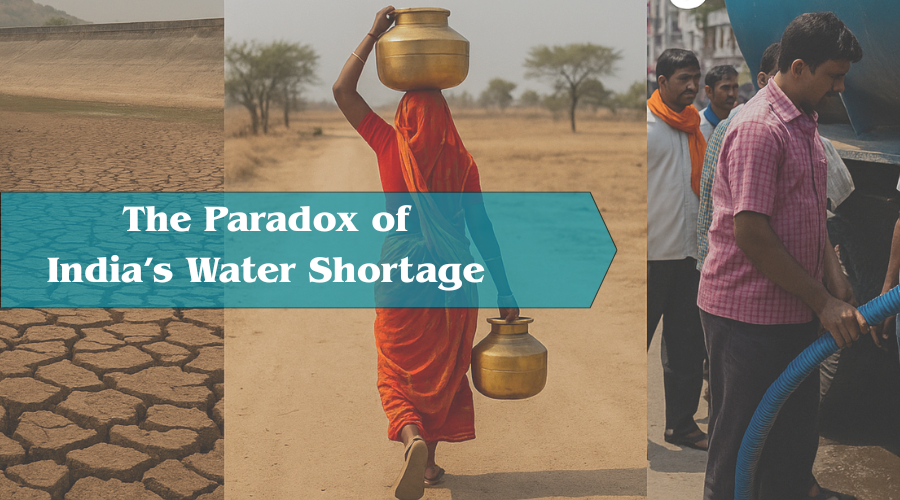
India stands at a pivotal moment, grappling with water scarcity issues across various regions. The country receives approximately 4000 BCM of rainfall each year, but due to inadequate conservation and management, only 18 to 20% of the water is usable. The growing demand for water and its limited availability has turned water scarcity into a national crisis.
India extracts nearly 25% of the world's groundwater but uses over 60% unsustainably each year. This makes the issue more complex than seasonal droughts. The urbanization in India is gradually eroding wetlands, while its distribution systems are overburdening infrastructure in both rural and urban areas.
According to the Jal Jeevan Mission 2023's data, cities like Bengaluru Are Experiencing a significant water shortfall of 400 million litres. In contrast, more than 50% of rural homes remain without pipe water connections, highlighting the Stark disparity in water access.
Weak governance has given rise to the tanker Mafia and proliferation of legal borewells. As water and air uncertainties escalate, people are proactively seeking sustainable solutions. These include rainwater harvesting and initiatives like Jal Jeevan Mission, aiming to address the issue on a large scale and at a faster pace.
Cities like Bengaluru and Chennai have always been the subject of discussion about how their water bodies dry up during the summer months.
Rapid urbanisation and declining rainfall in Bengaluru have put pressure on its infrastructure. Bengaluru Water Supply and Sewerage Board (BWSSB), the city's water supply agency, provides approximately 900 million litres of water daily. However, that demand is approximately 1.3 billion litres per day, resulting in a significant care that forces reliance on tankers and groundwater.
Despite being one of India's historical waters with cities, Chennai experienced a full-blown water crisis in 2019, when its four major reservoirs were almost empty. It officially reached a state of " Day zero", meaning no water was available. The primary causes of this issue are: lack of rain, over-extraction of groundwater, and the shrinking and degradation of lakes and wetlands. Despite recent rainfall, infrastructure challenges continue to affect the city's water supply. Tanker supplies have been discontinued in areas such as OMR and Sholinganallur, and the metro water supply has been reduced by 75%.
India accounts for roughly 25% of the world's groundwater, surpassing the combined extraction of all other countries. According to the Central Groundwater Board's 2024 report, India's annual groundwater extraction exceeds its recharge capacity by around 60%. This has led to 11% of the area being over-exploited, 3% being critical, and 11% being semi-critical.
Punjab & Haryana: Punjab and Haryana's Green Revolution-era subsidies have led to excessive groundwater extraction, accompanied by high levels of nitrate and uranium pollution (with Punjab's uranium levels exceeding 100 ppb, and Rajasthan also being impacted).
Rajasthan: Over 56% of the Rajasthan district faces extensive nitrate contamination.
Maharashtra: Nationwide assessment reviews Maharashtra's seven districts severely impacted by nitrates.
West Bengal: West Bengal's Ganges basin struggles with increased contamination during monsoon floods.
India uses over 3crore borewells, with 89% of groundwater going towards irrigation. Misuse of this threatens both food and water security. Rajasthan, Punjab, Maharashtra, and West Bengal are among the most effective states due to the depletion.
Tanker Mafia thrives as dams dry up:
Surprisingly, many areas, including Chennai, depend on private tankers, which are run by the water mafia for their survival. They not only charge excessive prices but also often resort to intimidation and strikes to get their way.
Surface water bodies are also drying up. Later, the district lost over 90% of its water sources in 2016, and now faces serious health issues.
Disappearing lakes and wetlands
Even around 70% of the rainfall, most of the water is not fit for use. The surrounding water bodies have been completely overwhelmed by pollution.
The burden of borewells drives farmer suicides:
Between 2007-2017, water reserves declined by nearly 61%.
The depletion, which has worsened since 2012, has led to increased distress and farmer suicides.
Farmers' electric pumps incur significant expenses, and they often resort to loans. The cost of installing borewells further compounds their debt, creating a crushing burden.
1. Rainwater harvesting and recharge initiatives
Bangalore homes and communities have adopted recharge systems to revive groundwater sources, enabling them to harvest and retain up to 60% of rainfall.
A groundbreaking water conservation project in Ahmednagar, India, features a network of three dams and 19 recharge pits. These innovative systems help to revive and recharge local resources, enabling sustainable use.
2. Jal Jeevan Mission & policy steps
The Jal Shakti Ministry was formed in 2019 and is now leading integrated water management efforts.
The Jal Jeevan Mission aims to deliver safe, piped water of good quality to every rural home. While progress has been notable, issues like wastewater management and regional infrastructure deficiency persist.
3. Smart irrigation with electric metres
The adoption of drip irrigation has increased significantly, from just 40 hectares in the 1960s to 351,000 hectares today, resulting in a substantial reduction in water usage for agriculture.
Due to excessive water usage caused by pumps, experts advocate for the installation of electricity meters to regulate and monitor consumption.
4. Groundwater governance & regulation
The call for regulations on borewell digging and usage is gaining momentum. Summary forms aim to manage groundwater extraction and integrate surface and groundwater resources.
The water crisis in India is more a result of reckless water usage and poor water resources management than natural causes. The growing dependence on borewells, combined with ecosystem mismanagement, has led to a severe water shortage affecting both cities and villages.
While the challenge is immense, scalable solutions exist- rainwater harvesting, drip irrigation, and strong policy implementation through schemes like Jal Jeevan Mission. A balanced mix of innovation, community participation, and governance can ensure India moves from water-stressed to water-secure, protecting both people and the environment.